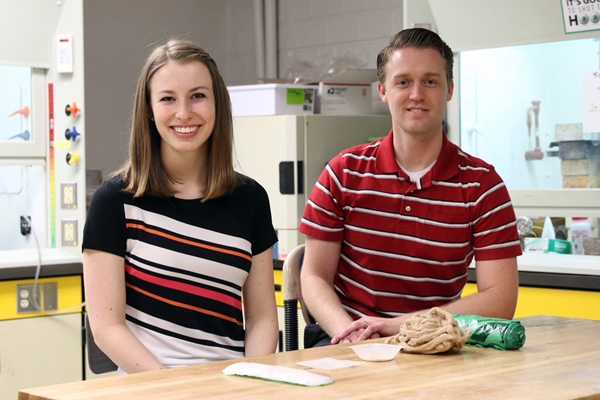
Amber Barron, left, and materials science professor Jeffrey Bates, with materials used in their biodegradable feminine hygiene pad (Dan Hixson, University of Utah)
16 May 2017. A group of engineering students in Utah developed a new feminine hygiene pad that, unlike most such products today, is made of fully natural materials and 100 percent biodegradable. The students, all undergraduates at University of Utah, also founded a company to develop and market the pad known as Shero.
The motivation for the Shero pad came from Sheva, a women’s empowerment organization in Guatemala, seeking a feminine hygiene product that could degrade faster when disposed. Few developing regions like Guatemala have effective public sanitation systems, and most used feminine hygiene pads and tampons today are packed in non-degradable plastic bags before disposed. Even in advanced Western countries, these waste products can take centuries to finally degrade.
The four Utah students that developed Shero are in a class led by materials science and engineering professor Jeffrey Bates, who studies properties of polymer plastics for health care and sustainable applications. In this case, the students aimed to not only develop a feminine hygiene pad that would degrade completely, but also one that is thinner and more comfortable than many environmentally friendly pads on the market today.
The students — Amber Barron, Sarai Patterson, Ashlea Patterson, and Alicia Dibble — under Bates’s guidance, tested out materials from natural sources that would not only efficiently absorb liquids, but also provide a barrier against leakage. The super-absorbent core of the Shero is made from agarose, a gel derived from seaweed and brown algae, placed under a transfer layer of 100 percent cotton. These two layers sit on top of a moisture barrier made from a corn-based material. Shero’s permeable outer layer is made from raw cotton, similar to a teabag.
“This is novel in comparison to other biodegradable options out there for pads,” says Barron in a university statement. “Most are really bulky because they don’t have a super-absorbent layer.” The team estimates the pad, once disposed, can break down completely within 6 months.
These readily available materials also make it possible for people in Guatemala and other developing regions to manufacture the pads, another objective of the students’ project. The students believe the pads, brand-named Chapina in Guatemala, can be made with locally sourced materials and without sophisticated equipment.
The student team founded the company Shero LLP in Bountiful, Utah to take the product to market. The company plans to partner with Sheva in Guatemala to set up a micro-franchising model for manufacturing and distribution of Chapina pads. The students also plan to market Shero pads in the U.S. for environmentally-conscious consumers.
Barron and Shero company colleague Alicia Dibble tell more about their company in the following video.
- Student Project Leads to Medical Device Start-Up
- Univ. Spin-Off Designing Heart Disease Screening App
- Univ. Spin-Off Developing Non-Toxic Bedbug Killer
- Univ. Spin-Off Develops Head Impact Sports Sensor
- Process Converts Food Waste to Auto Tire Materials
* * *

 RSS - Posts
RSS - Posts
You must be logged in to post a comment.